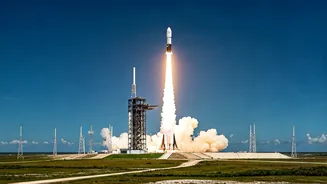Satellite Constellation Growth
SpaceX's recent success in deploying over 10,000 Starlink satellites represents a substantial expansion of its satellite internet service. This achievement
not only demonstrates SpaceX's operational capabilities but also enhances the Starlink network's capacity and coverage. This milestone is a critical step in providing high-speed, low-latency internet access to more users across the globe, especially in underserved areas. As the constellation grows, the network's efficiency increases, potentially improving connection speeds and reliability for existing and new customers. This rapid expansion positions SpaceX as a leader in the space-based internet market and shows its commitment to making internet access more accessible worldwide. The increasing density of the satellite network also allows for better management of network traffic and reduced latency, ensuring a more seamless user experience.
Setting Launch Records
In addition to the milestone of surpassing 10,000 satellites, SpaceX has set a new annual launch record, highlighting its dedication to frequent and efficient missions. This achievement involves multiple launches throughout the year, each contributing to the deployment of new Starlink satellites. The high frequency of launches is essential for rapidly expanding the Starlink constellation, which requires a continuous addition of satellites to maintain and improve coverage. SpaceX's ability to regularly launch rockets and deploy satellites at this scale shows its technical prowess. The setting of annual launch records also suggests that SpaceX is becoming even more efficient in its operations, reducing the time and resources required for each mission. These streamlined processes enable the company to keep up with the increasing demand for satellite internet services and further consolidate its position in the space industry.
Impact on Internet Access
The significant deployment of Starlink satellites has a broad impact on global internet access, potentially changing how people connect to the internet, particularly in remote or underdeveloped areas. Starlink aims to eliminate digital divides by providing high-speed internet to places where traditional broadband services are inadequate or unavailable. Satellite internet services are crucial for bridging the digital divide, allowing communities in remote locations to access online educational materials, healthcare services, and economic opportunities. Moreover, the enhanced connectivity facilitated by Starlink can empower businesses and individuals alike, driving economic development and increasing access to global information. With the number of satellites increasing, the service can reach more users and offer more reliable and consistent internet access.
Future Implications
The advancements in the Starlink project signal important changes for the future of space technology and global communication. As SpaceX continues to launch more satellites and expand its services, it will likely shape the landscape of the satellite internet industry. The company's ongoing innovations may influence the design and operation of future satellite systems. The increasing presence of Starlink satellites in orbit also brings the need for better space traffic management and sustainability practices. Collaboration between companies and organizations will be vital for ensuring long-term space utilization. The ongoing development of Starlink will influence the strategies of competitors and encourage further innovation in the field, ultimately fostering growth in space-based communication.












